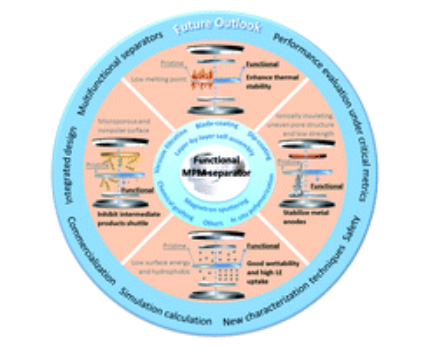Abstract
Separators in batteries have a great influence on their performance and safety, where both the properties of the separator and the separator-electrode interfaces affect ion diffusion. Microporous polyolefin membranes (MPM) with excellent properties are widely used as separators in commercial lithium batteries. However, MPM separators still suffer from serious thermal shrinkage and poor wettability, which lead to safety hazards and poor electrochemical performances. Furthermore, MPM separators cannot meet the higher requirements of next-generation high-energy-density batteries. With the fast progress in battery studies, researchers have gradually recognized that the separator is a favorable platform to address the key challenges of batteries. In this review, we provide an overview of the state-of-the-art research on the function-directed design of MPM separators. Firstly, we briefly present the challenges associated with conventional MPM separators. Then, we summarize the methods for the preparation of MPM-based functional separators. Subsequently, we highlight the main functions of MPM separators including improving the wettability of liquid electrolytes, enhancing the thermal stability, inhibiting the shuttling of intermediate products and stabilizing metal anodes. Finally, we present a summary and future outlook of MPM-based functional separators. Insights from this review show that MPM-based functional separators can significantly enhance the electrochemical performance and safety of batteries. Also, the rational design of advanced separators will play an increasingly important role in the future development of next-generation high-energy-density batteries.
Separators in batteries have a great influence on their performance and safety, where both the properties of the separator and the separator-electrode interfaces affect ion diffusion. Microporous polyolefin membranes (MPM) with excellent properties are widely used as separators in commercial lithium batteries. However, MPM separators still suffer from serious thermal shrinkage and poor wettability, which lead to safety hazards and poor electrochemical performances. Furthermore, MPM separators cannot meet the higher requirements of next-generation high-energy-density batteries. With the fast progress in battery studies, researchers have gradually recognized that the separator is a favorable platform to address the key challenges of batteries. In this review, we provide an overview of the state-of-the-art research on the function-directed design of MPM separators. Firstly, we briefly present the challenges associated with conventional MPM separators. Then, we summarize the methods for the preparation of MPM-based functional separators. Subsequently, we highlight the main functions of MPM separators including improving the wettability of liquid electrolytes, enhancing the thermal stability, inhibiting the shuttling of intermediate products and stabilizing metal anodes. Finally, we present a summary and future outlook of MPM-based functional separators. Insights from this review show that MPM-based functional separators can significantly enhance the electrochemical performance and safety of batteries. Also, the rational design of advanced separators will play an increasingly important role in the future development of next-generation high-energy-density batteries.

Keywords Plus:LITHIUM-SULFUR BATTERIESLI-S BATTERIESCOATED POLYPROPYLENE SEPARATORSENHANCED ELECTROCHEMICAL PERFORMANCEELECTRON-BEAM IRRADIATIONGEL POLYMER ELECTROLYTESMETAL-ORGANIC FRAMEWORKHIGH-AREAL-CAPACITYION BATTERIESHIGH-ENERGY
Published in JOURNAL OF MATERIALS CHEMISTRY A,Volume10;10.1039/d2ta03511a,JUL 12 2022


